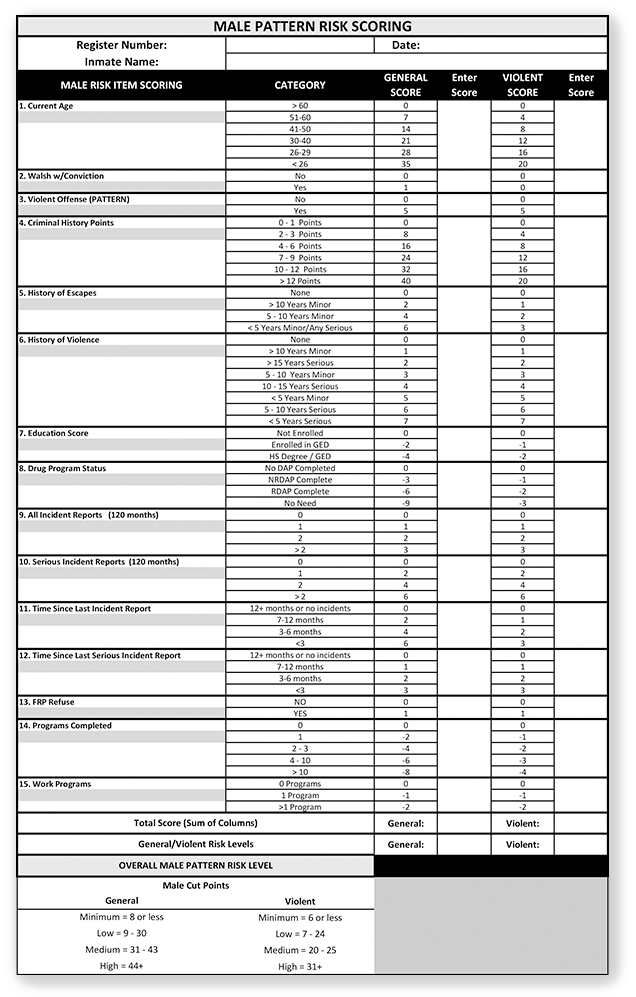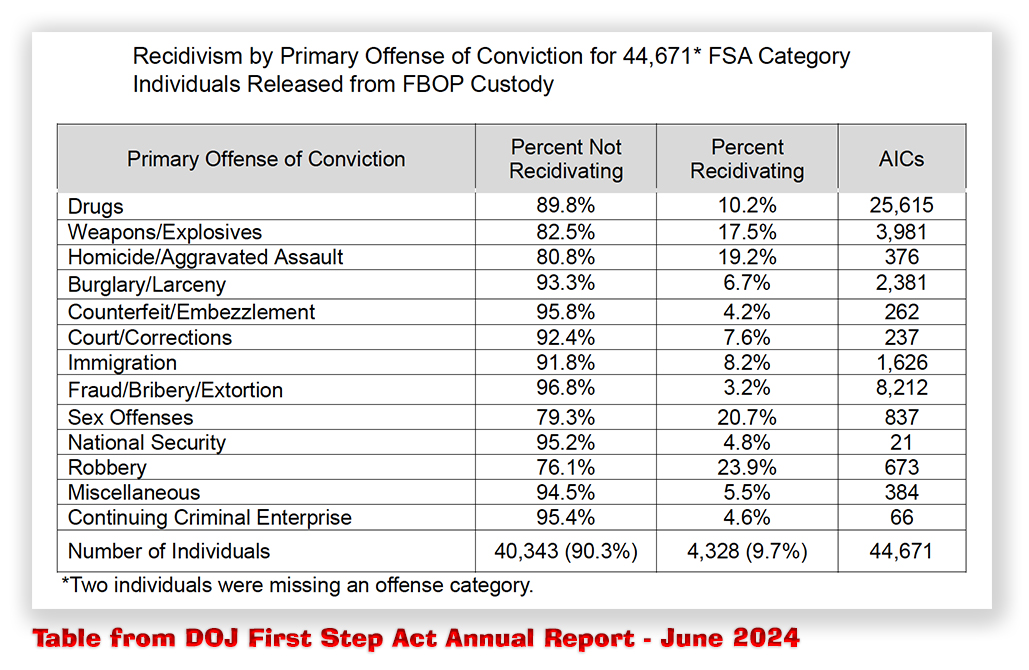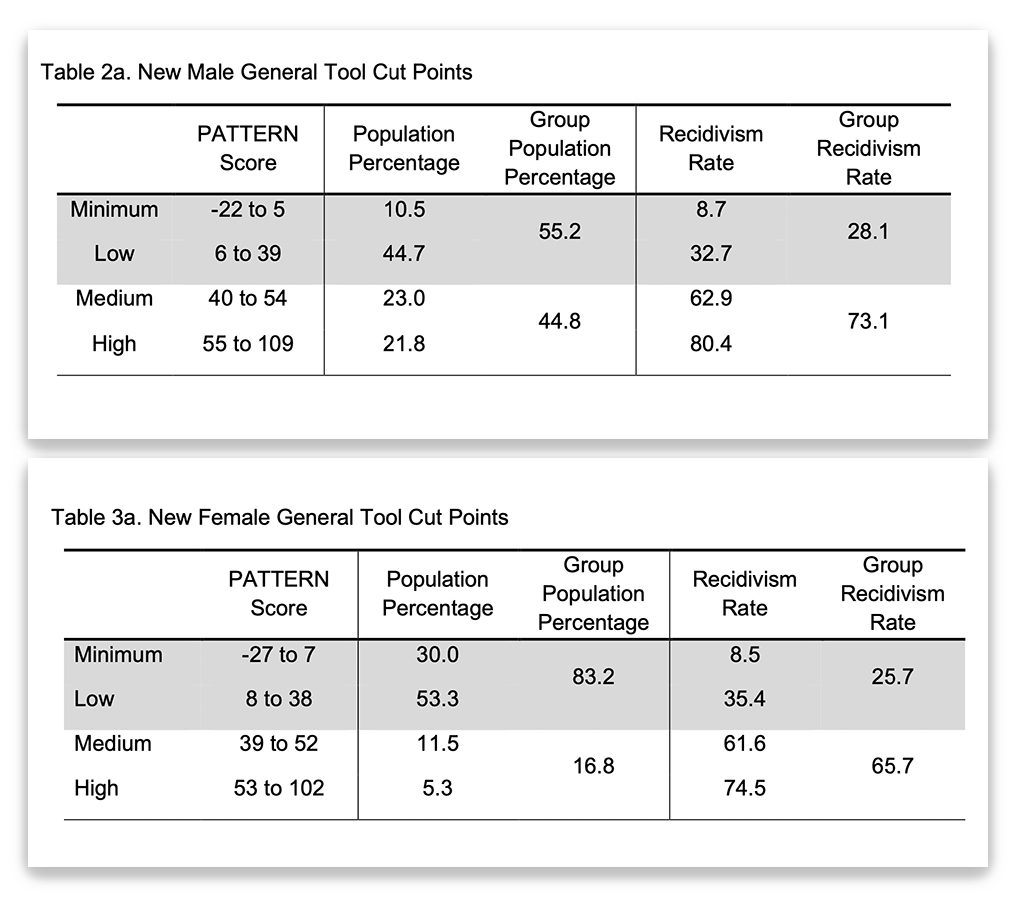We post news and comment on federal criminal justice issues, focused primarily on trial and post-conviction matters, legislative initiatives, and sentencing issues.

DOES PATTERN HAVE IT ALL WRONG?
One of the jewels in the First Step Act tiara has finally started to sparkle…. and it may turn out to have just been a rhinestone all along.
 First Step had as a goal the reduction of recidivism – the prison revolving door – by assessing each federal prisoner’s likelihood of recidivism, identifying the prisoner’s needs (anger management, substance abuse education, vocational training, and the like), and then offering programming that met those needs and was based on evidence that it would reduce recidivism (called “evidence-based recidivism reduction” or “EBRR” programming). The system is called PATTERN.
First Step had as a goal the reduction of recidivism – the prison revolving door – by assessing each federal prisoner’s likelihood of recidivism, identifying the prisoner’s needs (anger management, substance abuse education, vocational training, and the like), and then offering programming that met those needs and was based on evidence that it would reduce recidivism (called “evidence-based recidivism reduction” or “EBRR” programming). The system is called PATTERN.
To encourage inmates to participate in EBRR programs to address their needs, First Step offered earned time credits (called by the acronym-loving bureaucracy ETCs, or FTCs – federal time credits – or just TCs) to inmates who successfully complete EBRR programs or – after their needs are met – stay busy with productive activities (called PAs, of course). TCs are awarded on a daily basis – every day on which a prisoner takes a class is one day’s credit, and each day equals a third to a half of a TC. Inmates could trade in their TCs for up to a year off their sentence, or for more home confinement or more halfway house.
People with medium and high PATTERN scores can collect TCs, but only those with low and minimum PATTERN scores can spend them. Plus, the mediums and highs get one TC for every three days of programming. Lows and minimums get a half TC per day. In First Step parlance, a month of programming gets an inmate with a medium and high 10 TC days, but the prisoner with a low or minimum PATTERN scores gets 15.
TCs are sort of like airline miles: everyone can collect them, but using them can be tough.
The program only began on January 19, three years and a month after First Step enacted it. And it started with a bang, as the Bureau of Prisons retroactively awarded TCs for programs completed since December 2018. Currently, as Forbes noted a week ago, the BOP appears to be “prioritizing the release of those prisoners on home confinement or at halfway houses. Over the past 2 weeks, populations of those on home confinement and halfway house show thousands of people released from custody while the BOP populations have remained steady.”
The media have been excitedly reporting the releases, crediting the First Step Act, but Forbes poured some water on the fire: “Many advocates may be giving one another high-fives, but, as history has demonstrated, the BOP somehow finds a way to mess up a good thing.”
So what could possibly go wrong with such a wonderful program?  We’re 12 days into the programs, and warts are already starting to appear. Let’s start with the PATTERN score.
We’re 12 days into the programs, and warts are already starting to appear. Let’s start with the PATTERN score.
At a House Subcommittee on Crime, Terrorism and Homeland Security hearing 10 days ago, law professor Melissa Hamilton told legislators that as many as 10.9% of male and 9.8% of female prisoners have been assigned wrong risk categories due to errors in the PATTERN system. “The BOP has no plans to correct these errors,” she said in her written statement, “until a new version of PATTERN… is formally approved by the Attorney General.”
PATTERN errors include
• PATTERN was designed to score one’s risk factors as of the date of release, not the date of assessment. For example, if a 39-year-old man comes to prison for a 15-year sentence, he has a PATTERN age risk factor of 21. But PATTERN was designed to assess his age at release, which would be age 52. The risk factor for age 52 is only 7. The difference is 14 points. “Because the empirical models were estimated using different versions of these variables,” Professor Hamilton said, “it may have influenced the coefficients obtained and the item weights assigned. In other words, this definitional discrepancy across risk factors called into question the efficacy of the entire scoring system.”
• PATTERN operates with significant rates of error and disproportionately prefers false positives over false negatives. A false positive is the incorrect prediction of higher risk, while a false negative is the incorrect prediction of lower risk. This means that “a choice has been made to design PATTERN to perform far less accurately when predicting those who are at higher risk which means placing too many individuals into the higher risk groupings than necessary,” Hamilton told the subcommittee.
• PATTERN does not perform equally based on race and ethnicity. It “overpredicts the general risk for African Americans, Hispanic Americans, and Asian Americans, while it underpredicts for Native Americans.”
• Some BOP personnel are counting disciplinary infractions occurring when prisoners are in pretrial and holdover stages. A National Institute of Justice report last December said, “This means that as BOP is implementing PATTERN, they are currently scoring these infraction variables differently than were modeled in the report… which may have an impact on the utility of these two measures.”
Hamilton told the Subcommittee that “the various errors meant that 37 out of the possible 60 items (almost two-thirds of them) had been incorrectly weighted” in the PATTERN risk assessment. Due to these errors, according to the NIJ Report, overall, 11% of the BOP population was placed in the wrong risk category. This proportion may be on the low end.”
Last week, NPR reported that “about 14,000 men and women in federal prison… wound up in the wrong risk categories. There were big disparities for people of color. Criminal history can be a problem, for example, because law enforcement has a history of overpolicing some communities of color. Other factors such as education level and whether someone paid restitution to their victims can intersect with race and ethnicity, too.” At the same time, it also underpredicted the risk for some inmates of color when it came to possible return to violent crime.
The NIJ Report concluded that some of the racial disparities could be reduced, “but not without tradeoffs” such as less accurate risk predictions. The department also said using race as a factor in the algorithm could trigger other legal concerns. Still, it is consulting with experts about making the algorithm fairer and another overhaul of Pattern is already underway.”
 And it’s not only the errors inherent in PATTERN. Those exist even if the BOP staff follows the PATTERN scoring instructions to the letter. But they don’t: The NIJ Report also indicated a significant problem with reliability. “BOP personnel incorrectly scored and classified more than 20% of the BOP population,” Hamilton testified. “An automated system has been developed to improve reliability. However, it is unclear when/if the misclassifications from manual scoring will be remedied.”
And it’s not only the errors inherent in PATTERN. Those exist even if the BOP staff follows the PATTERN scoring instructions to the letter. But they don’t: The NIJ Report also indicated a significant problem with reliability. “BOP personnel incorrectly scored and classified more than 20% of the BOP population,” Hamilton testified. “An automated system has been developed to improve reliability. However, it is unclear when/if the misclassifications from manual scoring will be remedied.”
“Case managers, who have been keying in classes that prisoners have taken over the past two years, seem to have a liberal way of calculating ETC,” the Forbes writer said, “and those who I have spoken to about their release have no idea how their release date was calculated. As one man told me, ‘I was just happy to be released and don’t care how they calculated it’. However, for the man or woman sitting in prison, it makes a huge difference.”
Added to that is the fact that First Step included a number of offenses which will exempt an inmate from earning TCs. “The significance of this risk assessment tool is that it divides all federal prisoners essentially into two groups: people who can get credit for doing this programming and get out early, and people who can’t,” said Jim Felman, an attorney in Tampa, Florida, who has been following the First Step Act for years. Forbes said, “The law already has flaws as there are a number of exceptions carved out to prevent some offenses from being ineligible from earning ETC. Look for those to be challenged in court.”
The problem is worsened by BOP confusion in interpreting the 60-odd exceptions. Reports are rife of BOP staff errors – such as declaring an inmate ineligible over a prohibited conviction that occurred in the past rather than as the current offense, or advising inmates one that any drug trafficking offenses would exclude inmates only to withdraw the advice later. Many of the mistakes seem to be coming from the Designation and Sentence Computation Center at Grand Prairie.
As Forbes darkly predicted, “Look for those to be challenged in court.”
 Finally, the law failed to establish any standards for assessing what needs an inmate might have. A case manager must find a prisoner has a need (such as a need for anger management) before the inmate can earn TCs for completing a program addressing the need. Hamilton pointed out that “PATTERN is not itself a needs system. Instead, the BOP is relying, and purportedly improving, upon its preexisting policies and practices of identifying individual needs. This means that to date there has been no (publicly known) validation of the needs aspect of the broader system.”
Finally, the law failed to establish any standards for assessing what needs an inmate might have. A case manager must find a prisoner has a need (such as a need for anger management) before the inmate can earn TCs for completing a program addressing the need. Hamilton pointed out that “PATTERN is not itself a needs system. Instead, the BOP is relying, and purportedly improving, upon its preexisting policies and practices of identifying individual needs. This means that to date there has been no (publicly known) validation of the needs aspect of the broader system.”
“The BOP states that it is working to identify appropriate programs,” Hamilton testified, “At this time, though, a significant divide exists between program availability and individual demand in many BOP facilities. The result is a sort of lottery system whereby the luck of the draw in facility placement means some individuals will have a greater access to achieving earned time credits than others.”
The House Subcommittee will grill outgoing BOP Director Michael Carvajal at an oversight hearing this Thursday. Expect some pointed questions about PATTERN and TCs at that time.
Forbes, Bureau Of Prisons Begins Implementing First Step Act With Release Of Thousands In Custody (January 22, 2022)
Testimony of Law Professor Melissa Hamilton, before the House Subcommittee on Crime, Terrorism, and Homeland Security (January 21, 2022)
NPR, Flaws plague a tool meant to help low-risk federal prisoners win early release (January 26, 2022)
House Subcommittee on Crime, Terrorism, and Homeland, Scheduled Hearing on Oversight of the Federal Bureau of Prisons (scheduled for February 3, 2022)
– Thomas L. Root


 The National Institute of Justice released its 2023 Review and Revalidation of the First Step Act Risk Assessment Tool last week, suggesting that while there remains fine-tuning to be done, no one should expect any changes in how PATTERN is scored or, for that matter, calculated in next year or two.
The National Institute of Justice released its 2023 Review and Revalidation of the First Step Act Risk Assessment Tool last week, suggesting that while there remains fine-tuning to be done, no one should expect any changes in how PATTERN is scored or, for that matter, calculated in next year or two. NIJ conceded that while substantial criticism exists that rigid age brackets make it hard for prisoners to make meaningful changes in PATTERN risk categories, “individuals can change their risk scores and levels during confinement beyond mere age effects. Those who reduced their RLC from first to last assessment were shown to have the lowest recidivism rates, followed by those who maintained the same risk level and those with a higher risk level, respectively.”
NIJ conceded that while substantial criticism exists that rigid age brackets make it hard for prisoners to make meaningful changes in PATTERN risk categories, “individuals can change their risk scores and levels during confinement beyond mere age effects. Those who reduced their RLC from first to last assessment were shown to have the lowest recidivism rates, followed by those who maintained the same risk level and those with a higher risk level, respectively.”  “Of the BOP’s nearly 160,000 prisoners,” Pavlo wrote, “24,000 of them are minimum security. The BOP’s statement was that the average cost of housing a minimum security prisoner in 2024 is $151.02. The cost of housing someone in a US penitentiary is $164.87 (Lows were $129.72 and Mediums are $122.50). Since there are more minimum security prisoners than high, the total costs of housing minimum security prisoners far exceeds the costs of housing those in high security….”
“Of the BOP’s nearly 160,000 prisoners,” Pavlo wrote, “24,000 of them are minimum security. The BOP’s statement was that the average cost of housing a minimum security prisoner in 2024 is $151.02. The cost of housing someone in a US penitentiary is $164.87 (Lows were $129.72 and Mediums are $122.50). Since there are more minimum security prisoners than high, the total costs of housing minimum security prisoners far exceeds the costs of housing those in high security….”























